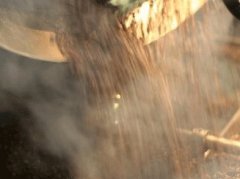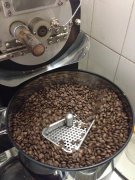English Corner | Why do we bake coffee and raw beans?
Love coffee
Is an elegant way of life.
Love coffee
Let's get together!

Coffee beans are the seeds of the cherries of the coffee tree. Each cherrytypically contains two beans whose flat sides face each other. When steepedin hot water, raw, or "green", coffee beans offer little in the way of what one might relate to as coffee taste and aroma.
Coffee beans are the seeds of the fruit of coffee trees. Each fruit usually contains two coffee beans, with the flat side opposite to each other. When coffee beans are soaked in hot water (when not roasted), the taste and aroma may be revealed slightly.

Roasting green coffee creates myriad chemical changes, the production and breakdown of thousands of compounds, and, the roaster hopes, the development of beautiful flavors when the beans are ground and steeped in hot water. Among its many effects, roasting causes beans to:
The process of roasting coffee and raw beans will produce numerous chemical changes, and thousands of compounds will be broken down or reorganized. The roaster hopes that the roasted coffee will show a beautiful cup flavor after being ground and extracted. Roasting will change the raw coffee beans in the following ways:

▲ Change in color from green to yellow to tan to brown to black
Causes the color to change, green, yellow, yellowish brown, brown and black
▲ Nearly double in size
Coffee beans are almost twice as big as before.
▲ Become half as dense
The density is half of what it was before.
▲ Gain, and then lose, sweetness
(with the deepening of baking) the sweetness is highlighted and then lost.
▲ Become much more acidic
The sour taste is highlighted.
▲ Develop upwards of 800 aroma compounds.
Or produce more than 800 aromatic compounds.
▲ Pop loudly as they release pressurized gases and water vapor.
Bursting sound caused by the release of gas and steam from coffee beans (during baking)

The goal of roasting is to optimize the flavors of coffee's soluble chemistry. Dissolved solids make of brewed coffee's taste, while dissolved volatile aromatic compounds and oils are responsible for aroma. Dissolved solids, oils, and suspended particles, primarily fragments of bean cellulose, create coffee's body.
The purpose of roasting is to optimize the soluble flavor substances in coffee. Soluble solids determine the taste of coffee, while soluble aromatic compounds and oils affect the aroma of coffee. Soluble solids, oils and suspended particles (mainly cellulose in beans) give coffee a taste.
Important Notice :
前街咖啡 FrontStreet Coffee has moved to new addredd:
FrontStreet Coffee Address: 315,Donghua East Road,GuangZhou
Tel:020 38364473
- Prev

Professional roasting theory of coffee beans roasting aroma elves
Grab a handful of coffee raw beans smell, there is always a pungent smell, very different from the impression of the charming smell of coffee. However, after roasting "fragrance" correctly, raw beans will emit the strongest aroma in the world. The small high-altitude Arabica coffee raw beans are like a warehouse full of chemicals. At present, scientists have identified more than 2,000 known ingredients, including 700 to 700.
- Next

Why do we have to bake coffee beans ourselves?
So why bake your own coffee beans? 1. Freshness brings the best flavor. Stale bread is not like stale coffee beans, the former cannot be eaten if it is not fresh, while the latter can still be drunk even if it has changed, and some people even enjoy it. Most people do not know that coffee brewed from freshly roasted coffee beans will explode with strong aroma.
Related
- Beginners will see the "Coffee pull flower" guide!
- What is the difference between ice blog purified milk and ordinary milk coffee?
- Why is the Philippines the largest producer of crops in Liberia?
- For coffee extraction, should the fine powder be retained?
- How does extracted espresso fill pressed powder? How much strength does it take to press the powder?
- How to make jasmine cold extract coffee? Is the jasmine + latte good?
- Will this little toy really make the coffee taste better? How does Lily Drip affect coffee extraction?
- Will the action of slapping the filter cup also affect coffee extraction?
- What's the difference between powder-to-water ratio and powder-to-liquid ratio?
- What is the Ethiopian local species? What does it have to do with Heirloom native species?

